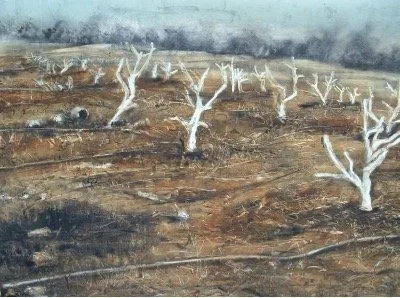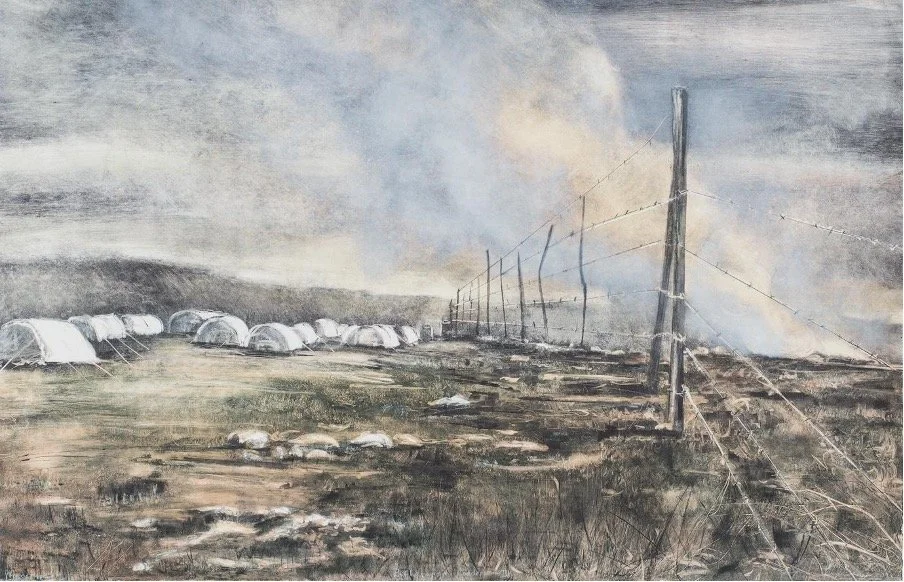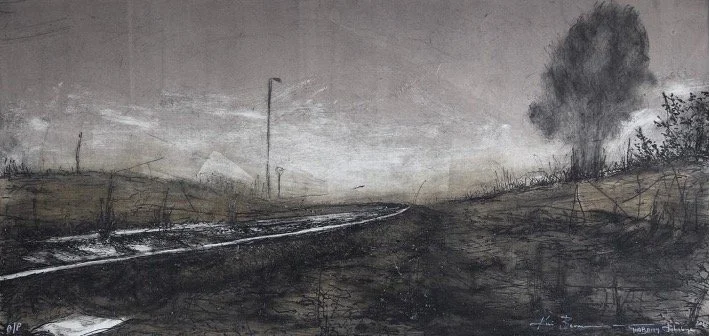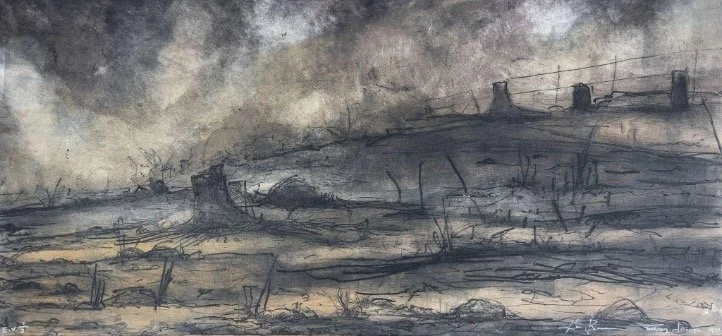Xenophobia and the Dislocated Landscapes series
Pamela Allara
In a statement for the brochure of her exhibition, “Dislocated Landscapes,” (2009) at the Massachusetts College of Art and Design, Kim Berman wrote: “Landscapes have always provided a metaphor for our transitions as a country; even in a poisoned, burnt or smoke-filled landscape, the light on the horizon sparks the energy and hope for the cycle of change and the imperative of renewal.” The optimism of this statement belies its context: in May 2008, xenophobic violence against ‘aliens’ (foreign nationals) broke out across the nation, killing 62 and displacing thousands. “Go home or die here” was the threatening slogan - hardly a viable option for people with nowhere to go. The survivors were literally dumped into tents outside the cities, and after six months they were returned to the areas where they had formerly resided, and where they were likely to be marginalized or physically threatened. There was no home to go to for those who were raped, beaten, or murdered during the outbreaks, nor for the nearly 80,000 ejected from their vulnerable domiciles. The uprisings began in Johannesburg’s Alexandra Township but spread to other parts of the country.
In her etching Dislocated Landscape I, Berman has situated a row of white tents to the far left of the image, whereas the two fences centre and right create a disjunctive space that symbolizes the obstacles that refugees would face on their return. It is also a broader metaphor for the failure of South Africa post-1994 to create a ‘rainbow nation’ where all citizens would be equal in terms of social and economic opportunities. In other words, the landscapes dislocate “the space for democracy in South Africa.”
Dislocated Landscape I, 2009, Etching monoprint from variable edition
Throughout her oeuvre, Berman has sought to witness and process South Africa’s traumas through landscape. The landscapes she created in response to xenophobia in South Africa seem sterile with whited dislocation and regimented emptiness. The Dislocated Landscapes series from 2009 is her deeply felt response to the violent xenophobic outbreaks in May 2008 that shook South African society to its core. Berman commented: “This period seemed to betray many of the fundamental values of community, inclusion, participation and ubuntu, and took South Africans further away from the democratic society we imagined for ourselves when the constitution was written in the 1990s.”
Characterized by stark renderings of the white United Nations tents in the hastily organized ‘refugee’ camps outside of Johannesburg, the prints speak to the victims’ devastating losses and isolation, as well as to memories of past injustices. The encampments were non-places, uncanny in their utter distance from anything that could be identified as home.
Although grounded in direct observation, her work has always served as a vehicle to reflect on the emotional temperature of her country at any time. For Berman, history and culture are rooted in the locus of human habitation: the landscape provides her with the terrain to assess the nation’s struggles, its ongoing challenges, and its traumas.
In all her work, Berman begins with a literal source - photographs taken while traveling - and then expands these initial notes into a theme that is explored through a suite of prints. Just as prints are a multiple medium, so her use of multiple images on a single theme provide a means to investigate her chosen metaphors, and to avoid simplistic or didactic statements.
Winter Camp 1 and Alien Landscape, 2009, Monotypes
The Dislocated Landscapes prints have pronounced foreground textures, a device that serves two opposing purposes: on one hand, it provides a grounding for the viewer, who enjoys the momentary illusion of standing in the space. On the other, because the brown-ochre reeds and leaves are frequently uprooted and unidentifiable, this illusion is abruptly broken. The view is made unfamiliar, and the viewer disabused of any genuine sense of belonging.
Rifle Range I, Roodepoort, 2009, Monotype
In Berman’s large monoprint Rifle Range I, Roodepoort, the roiling sky and motionless tents contrast the stasis of a world without options with the turbulence that has led to this endpoint. Moreover, the title ensures that it is impossible to miss the irony of setting up a refugee camp for the targets of violence in a former military rifle range.
In early 2008, Berman had travelled to White River in Mpumalanga with a former student, Thabang Lehoybe, to record the damage caused by the devastating forest fires in the region. Together, they produced a suite of prints, Through the Forest Fires: A Mpumalanga Journey.
Two prints from the Mpumalanga Journey suite: a collaboration between Thabang and Kim, 2008
In the Dislocated Landscapes prints, white is suggestive of the prospect of death. After the 2008 fires in Mpumalanga that annihilated the source of much of the country’s fresh fruit produce, the farmers limed the stumps of the burnt fruit trees to protect the exposed bark and permit new growth.
Alien Landscape I and II White River, 2008, Etchings
To Kim, they became “the shameful markings of the other.” In the etchings Alien Landscapes I and II, the extended branches on the white stumps suggest human arms, of people either fleeing or surrendering. Both landscapes at first appear normal: sights one would frequently pass by, but on further contemplation they become disturbing reflections on violence and its aftermath. Understanding this causes the viewers to question their assumptions about South African history and its problematic present. The foreground spaces provide visual entry points - one can imagine standing in those fields. Why are we reluctant to enter? It is not a simple matter to face the past and one’s often privileged position in it.
Whether the viewer is confronted by rows of white refugee tents, or by white tree stumps, the land itself is consistently split apart - bifurcated into rocky slopes on one side and by low, dry brush on the other, characterized by barren, isolated ‘no-man’s-lands’, often hemmed in with barbed wire fences that claim ownership by faceless authorities. In all the Dislocated Landscapes prints, white is suggestive of the prospect of death, and the empty tents, unable to sustain life, more closely resemble burial shrouds.
Berman’s metaphors for the powerful emotions elicited by the events of May 2008 and afterwards are not reducible to any one interpretation or argument. Because these landscapes do reference a specific moment of political crisis, they require the viewer to contemplate how they relate to what has come before and to imagine their implications for the future. The vistas depicted in this series are stark and barren, but they are also beautiful: the expansive spaces and broad horizons provide the viewer with the room to connect mentally with past violence as well as with future restitution.
On June 8, a fire in Kim’s home destroyed her study, but left the other living spaces intact. Destroyed were invaluable documents and images: a portrait by Irma Stern of Kim’s grandfather, her mother’s collection of Irma Stern sketches, Kim’s artists book collection, journals, archival records, and some books. In Burnt Walls and Ghosts, an installation she has designed for the gallery, the images of the destroyed study and the burned books on her desk will suggest the power of fire both to destroy and recreate, and the study will be reimagined. Kim asserts that both the fire and the exhibition have provided her with the opportunity to renew and reinvent herself. She has both the imagination and the courage to do so.







